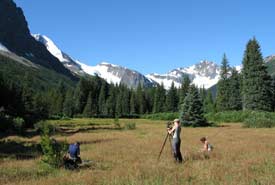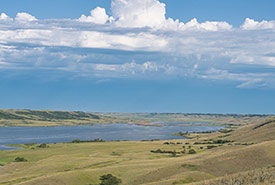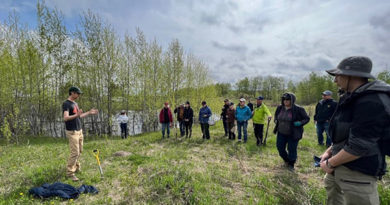NCC: Land Lines – Black ash, beetles and beavers
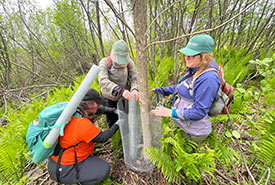
Kayla, Olivia and Jen caging a black ash tree (Photo by Julia Ball/NCC)
By Julia Ball, Kayla Fisher and Olivia Lymburner
Three of us, Julia Ball, Kayla Fisher and Olivia Lymburner, had the pleasure of being conservation interns with the Nature Conservancy of Canada (NCC) in Newfoundland and Labrador during the summer of 2023. As we embarked on this journey, we found ourselves immersed in a unique opportunity to engage in the pursuit of species-at-risk monitoring within the captivating landscapes of our province. Species-at-risk monitoring involves assessing the condition of a given species and following remedial measures with the intent of improving its trajectory. These remedial measures come from provincial and/or federal policies that recognize the species’ threatened position. Typically, this process uses numerous tactics designed to promote overall species recovery.
Black ash, the eastern North American native arboreal treasure, dances on the verge of extinction. Inside the borders of Newfoundland and Labrador, black ash is categorized as threatened, indicating that this species has a relatively high risk of becoming endangered or extinct if its population continues to decline. Black ash faces an ensemble of threats, including moose and beaver browsing, wood harvesting and unyielding escalation of climate change.
Black ash trees are a rarity in Newfoundland, and are mostly found in the southern and southwestern regions. They thrive in wetland habitats, enduring flooding and wet conditions. Interestingly, beavers also prefer wetlands and often modify their habitats by building dams and lodges. While beaver activity can lead to flooding and changes in the ecosystem, this flooding can create the perfect environment for black ash trees. However, beavers also feed on these trees, posing a threat to the trees’ survival. Despite this, black ash trees persevere with a survival mechanism called suckering, where new shoots sprout from the base of the tree when the main stem is damaged.
One of our accomplishments this year was taking steps to protect the black ash population from beaver damage. We set up wire fences around the base of each tree, safeguarding them from beaver activity. This allows the trees to strengthen their numbers and expand throughout the landscape.
This proactive approach also prepares us to handle any potential threat from an unexpected catalyst for this species’ demise: a tiny, wood-boring beetle that is wreaking havoc outside of its native range.
Emerald ash borer beetles (EAB), native to parts of Asia, were first detected in Canada in 2002. EAB larvae insidiously feed on nutrient-rich tissue just under the bark of ash trees, disrupting its ability to transport water and nutrients needed to sustain its existence. While EAB has devastated ash populations in other parts of North America, Newfoundland’s isolation has acted as a shield against the EAB invasion. The island’s natural defenses have helped black ash trees to continue growing, allowing scientists the opportunity to observe a healthy population of black ash to inform conservation efforts.
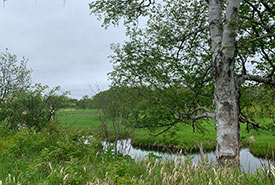
Black Ash Nature Reserve, NL (Photo by Julia Ball/NCC)
Our mission this year took us to NCC’s Black Ash Nature Reserve alongside Jennifer Sullivan, stewardship coordinator for NCC in Newfoundland and Labrador. We began by checking on previously tagged trees and replacing tags as needed. Tags that are worn by the weather or that are outgrown by the tree, get replaced as needed. Next, we identified and tagged more black ash trees and installed protective cages around some of them. By tagging the trees and assessing their health, we contribute to a continuous monitoring effort. This data not only informs our conservation efforts but is also shared with the provincial wildlife department to aid in their conservation plans.
As conservation interns with NCC, we have gained a unique perspective on the delicate balance between ecosystems and species protection. Our involvement in species monitoring, particularly vulnerable black ash trees, has highlighted the importance of proactive conservation in protecting the region’s ecological treasures. By tagging, assessing and caging trees, we are contributing to a comprehensive understanding of black ash health and growth patterns.
Since NCC acquired the Black Ash Nature Reserve in 2012, the number of black ash trees has grown from 32 to 106, with us contributing to the discovery of 30 new trees this year alone. We’ve also shielded 10 trees with protective cages. Our efforts align with NCC’s goals of habitat and biodiversity conservation. Ultimately, our experience with black ash trees highlights the tenacity of nature and the urgency of our stewardship in protecting our planet’s health.


